2014 MERCEDES-BENZ SLS AMG GT COUPE lights
[x] Cancel search: lightsPage 45 of 290
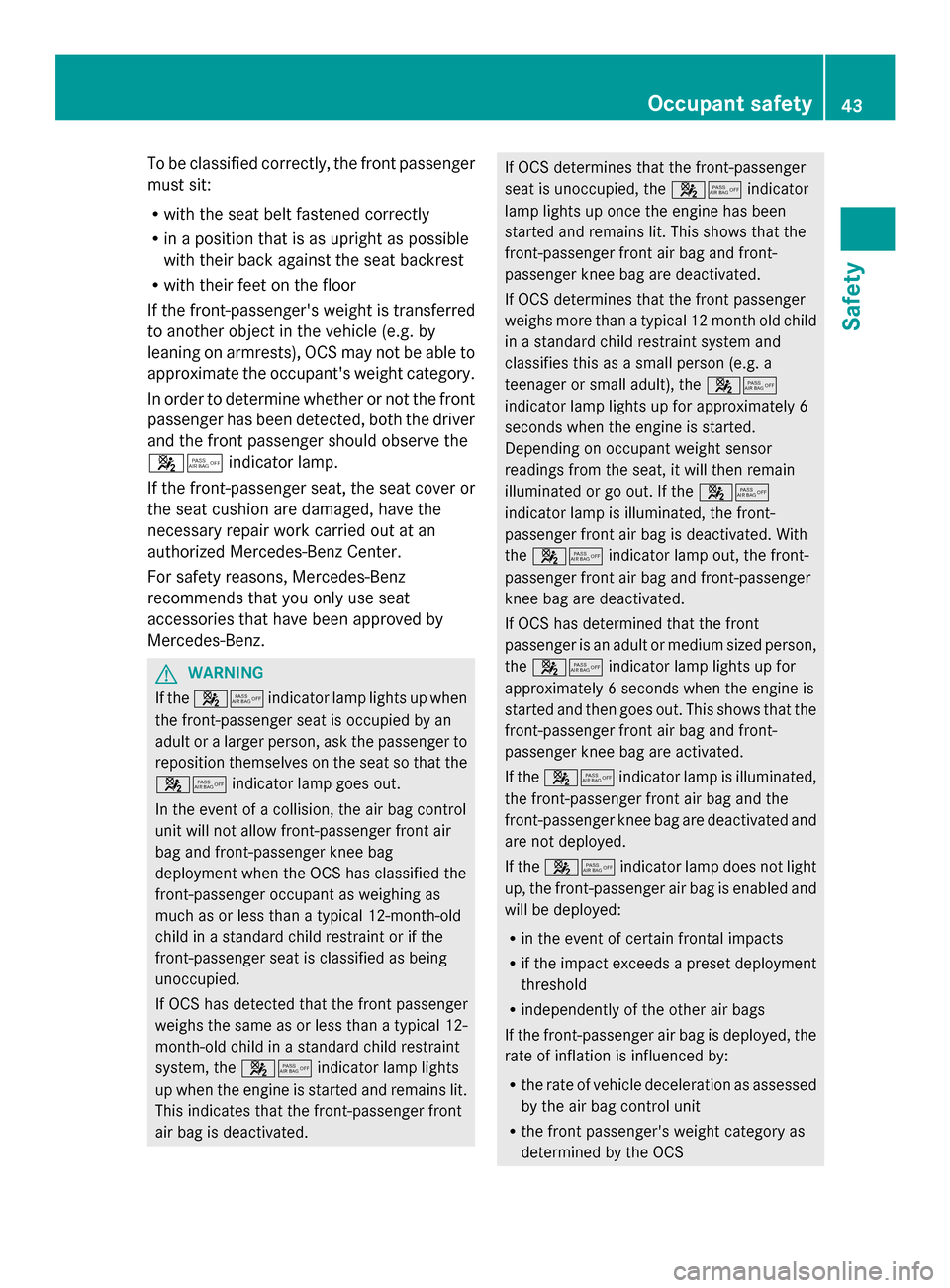
To be classified correctly, the front passenger
must sit:
R with the seat belt fastened correctly
R in a position that is as upright as possible
with their back against the seat backrest
R with their feet on the floor
If the front-passenger's weight is transferred
to another object in the vehicle (e.g. by
leaning on armrests), OCS may not be able to
approximate the occupant's weight category.
In order to determine whether or not the front
passenger has been detected, both the driver
and the front passenger should observe the
00730074 indicator lamp.
If the front-passenger seat, the seat cover or
the seat cushion are damaged, have the
necessary repair work carried out at an
authorized Mercedes-Benz Center.
For safety reasons, Mercedes-Benz
recommends that you only use seat
accessories that have been approved by
Mercedes-Benz. G
WARNING
If the 00730074 indicator lamp lights up when
the front-passenger seat is occupied by an
adult or a larger person, ask the passenger to
reposition themselves on the seat so that the
00730074 indicator lamp goes out.
In the event of a collision, the air bag control
unit will not allow front-passenger front air
bag and front-passenger knee bag
deployment when the OCS has classified the
front-passenger occupant as weighing as
much as or less than a typical 12-month-old
child in a standard child restraint or if the
front-passenger seat is classified as being
unoccupied.
If OCS has detected that the front passenger
weighs the same as or less than a typical 12-
month-old child in a standard child restraint
system, the 00730074indicator lamp lights
up when the engine is started and remains lit.
This indicates that the front-passenger front
air bag is deactivated. If OCS determines that the front-passenger
seat is unoccupied, the
00730074indicator
lamp lights up once the engine has been
started and remains lit. This shows that the
front-passenger front air bag and front-
passenger knee bag are deactivated.
If OCS determines that the front passenger
weighs more than a typical 12 month old child
in a standard child restraint system and
classifies this as a small person (e.g. a
teenager or small adult), the 00730074
indicator lamp lights up for approximately 6
seconds when the engine is started.
Depending on occupant weight sensor
readings from the seat, it will then remain
illuminated or go out. If the 00730074
indicator lamp is illuminated, the front-
passenger front air bag is deactivated. With
the 00730074 indicator lamp out, the front-
passenger front air bag and front-passenger
knee bag are deactivated.
If OCS has determined that the front
passenger is an adult or medium sized person,
the 00730074 indicator lamp lights up for
approximately 6 seconds when the engine is
started and then goes out. This shows that the
front-passenger front air bag and front-
passenger knee bag are activated.
If the 00730074 indicator lamp is illuminated,
the front-passenger front air bag and the
front-passenger knee bag are deactivated and
are not deployed.
If the 00730074 indicator lamp does not light
up, the front-passenger air bag is enabled and
will be deployed:
R in the event of certain frontal impacts
R if the impact exceeds a preset deployment
threshold
R independently of the other air bags
If the front-passenger air bag is deployed, the
rate of inflation is influenced by:
R the rate of vehicle deceleration as assessed
by the air bag control unit
R the front passenger's weight category as
determined by the OCS Occupant safety
43Safety Z
Page 49 of 290
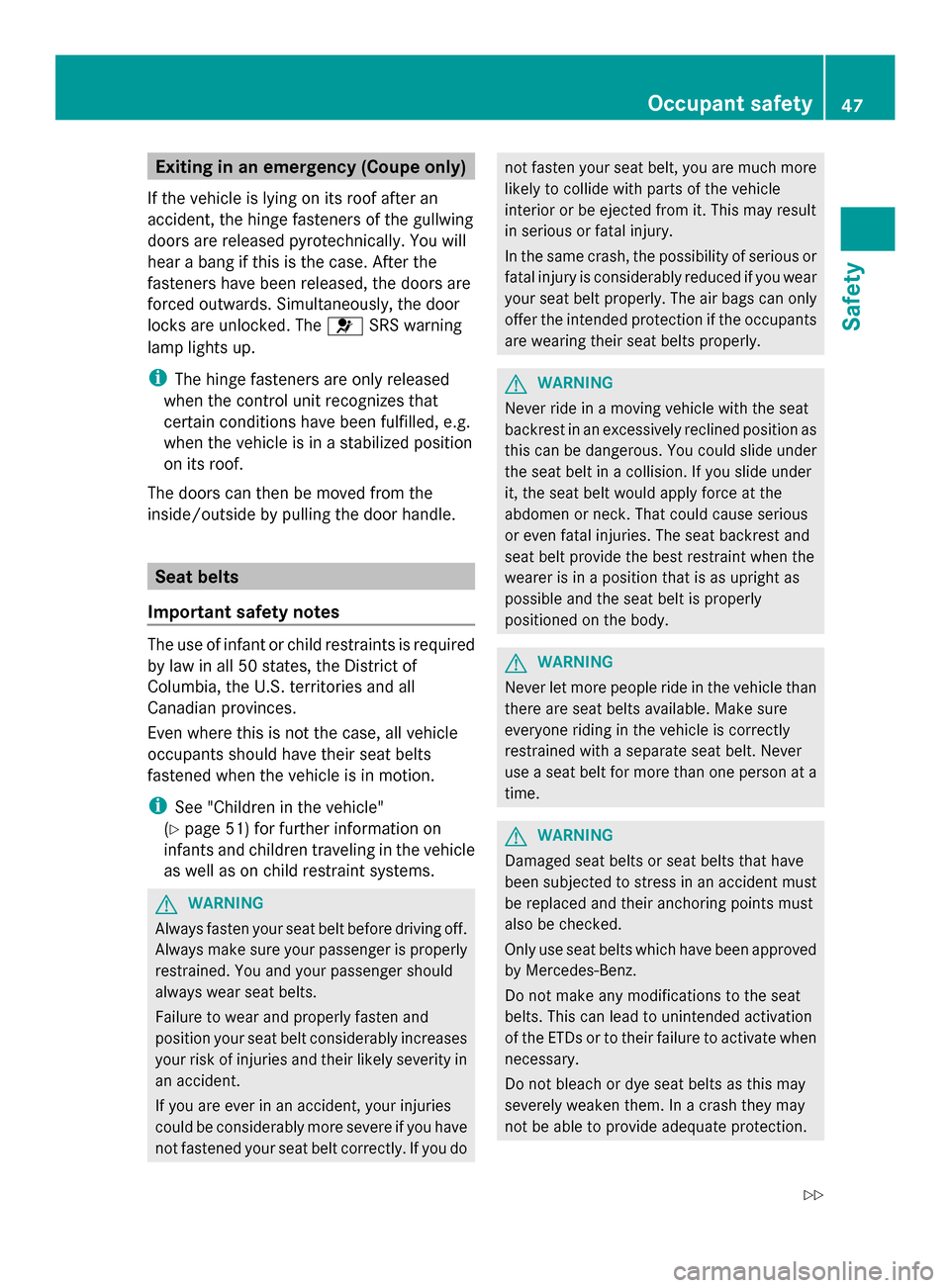
Exiting in an emergency (Coupe only)
If the vehicle is lying on its roof after an
accident, the hinge fasteners of the gullwing
doors are released pyrotechnically. You will
hear a bang if this is the case. After the
fasteners have been released, the doors are
forced outwards. Simultaneously, the door
locks are unlocked. The 0075SRS warning
lamp lights up.
i The hinge fasteners are only released
when the control unit recognizes that
certain conditions have been fulfilled, e.g.
when the vehicle is in a stabilized position
on its roof.
The doors can then be moved from the
inside/outside by pulling the door handle. Seat belts
Important safety notes The use of infant or child restraints is required
by law in all 50 states, the District of
Columbia, the U.S. territories and all
Canadian provinces.
Even where this is not the case, all vehicle
occupants should have their seat belts
fastened when the vehicle is in motion.
i See "Children in the vehicle"
(Y page 51) for further information on
infants and children traveling in the vehicle
as well as on child restraint systems. G
WARNING
Always fasten your seat belt before driving off.
Always make sure your passenger is properly
restrained. You and your passenger should
always wear seat belts.
Failure to wear and properly fasten and
position your seat belt considerably increases
your risk of injuries and their likely severity in
an accident.
If you are ever in an accident, your injuries
could be considerably more severe if you have
not fastened your seat belt correctly. If you do not fasten your seat belt, you are much more
likely to collide with parts of the vehicle
interior or be ejected from it. This may result
in serious or fatal injury.
In the same crash, the possibility of serious or
fatal injury is considerably reduced if you wear
your seat belt properly. The air bags can only
offer the intended protection if the occupants
are wearing their seat belts properly.
G
WARNING
Never ride in a moving vehicle with the seat
backrest in an excessively reclined position as
this can be dangerous. You could slide under
the seat belt in a collision. If you slide under
it, the seat belt would apply force at the
abdomen or neck. That could cause serious
or even fatal injuries. The seat backrest and
seat belt provide the best restraint when the
wearer is in a position that is as upright as
possible and the seat belt is properly
positioned on the body. G
WARNING
Never let more people ride in the vehicle than
there are seat belts available. Make sure
everyone riding in the vehicle is correctly
restrained with a separate seat belt. Never
use a seat belt for more than one person at a
time. G
WARNING
Damaged seat belts or seat belts that have
been subjected to stress in an accident must
be replaced and their anchoring points must
also be checked.
Only use seat belts which have been approved
by Mercedes-Benz.
Do not make any modifications to the seat
belts. This can lead to unintended activation
of the ETDs or to their failure to activate when
necessary.
Do not bleach or dye seat belts as this may
severely weaken them. In a crash they may
not be able to provide adequate protection. Occupant safety
47Safety
Z
Page 51 of 290

Fastening seat belts
G
WARNING
Children 12 years old and under must be
seated and properly secured in an
appropriately sized infant restraint, child
restraint system, or booster seat
recommended for the size and weight of the
child. For additional information, see the
"Children in the vehicle" section.
A child's risk of serious or fatal injuries is
significantly increased if the child restraints
are not properly secured in the vehicle and/
or the child is not properly secured in the child
restraint. Example: Coupe
X
Adjust the seat and move the backrest to
an almost vertical position(Y page 85).
X Pull the seat belt smoothly from belt sash
guide 0043.
X Without twisting it, guide the shoulder
section of the seat belt across the middle
of your shoulder and the lap section across
your hips. X
Engage belt tongue 0044in buckle 0087.
X If necessary, pull upwards on the shoulder
section of the seat belt to tighten the belt
across your body.
The seat belt on the front-passenger side is
equipped with a special seat belt retractor to
secure child restraint systems properly on the
front-passenger seat. For further information
on special seat belt retractors, see
(Y page 53).
For more information about releasing the seat
belt with release button 0085, see "Releasing
seat belts" ( Ypage 49).
Releasing seat belts X
Press release button 0085(Ypage 49) and
guide belt tongue 0044(Ypage 49) back
towards belt sash guide 0043(Ypage 49).
! Make sure that the seat belt is fully rolled
up. Otherwise, the seat belt or belt tongue
will be trapped in the door or in the seat
mechanism. This could damage the door,
the door trim panel and the seat belt.
Damaged seat belts can no longer fulfill
their protective function and must be
replaced. Consult an authorized Mercedes-
Benz Center.
Belt warning for the driver and front
passenger Regardless of whether the driver's and front-
passenger seat belts have already been
fastened, the
0076seat belt warning lamp
lights up for six seconds each time the engine
is started. It then goes out once the driver and
the front passenger have fastened their seat
belts.
If the driver's seat belt is not fastened when
the engine is started, an additional warning
tone will sound. The warning tone switches
off after approximately six seconds or once
the driver's seat belt is fastened. Occupant safety
49Safety Z
Page 52 of 290
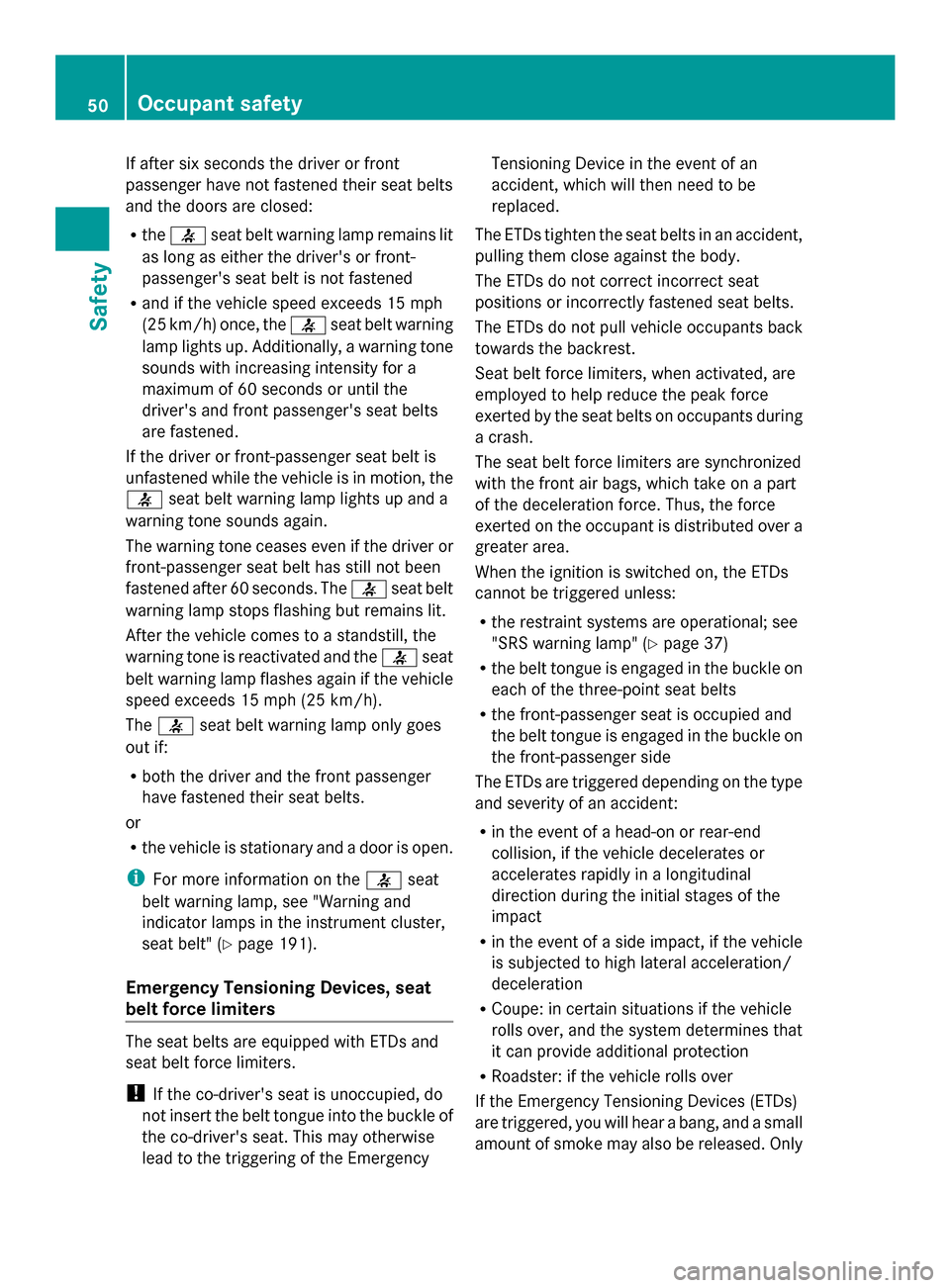
If after six seconds the driver or front
passenger have not fastened their seat belts
and the doors are closed:
R the 0076 seat belt warning lamp remains lit
as long as either the driver's or front-
passenger's seat belt is not fastened
R and if the vehicle speed exceeds 15 mph
(25 km/h) once, the 0076seat belt warning
lamp lights up. Additionally, a warning tone
sounds with increasing intensity for a
maximum of 60 seconds or until the
driver's and front passenger's seat belts
are fastened.
If the driver or front-passenger seat belt is
unfastened while the vehicle is in motion, the
0076 seat belt warning lamp lights up and a
warning tone sounds again.
The warning tone ceases even if the driver or
front-passenger seat belt has still not been
fastened after 60 seconds. The 0076seat belt
warning lamp stops flashing but remains lit.
After the vehicle comes to a standstill, the
warning tone is reactivated and the 0076seat
belt warning lamp flashes again if the vehicle
speed exceeds 15 mph (25 km/h).
The 0076 seat belt warning lamp only goes
out if:
R both the driver and the front passenger
have fastened their seat belts.
or
R the vehicle is stationary and a door is open.
i For more information on the 0076seat
belt warning lamp, see "Warning and
indicator lamps in the instrument cluster,
seat belt" (Y page 191).
Emergency Tensioning Devices, seat
belt force limiters The seat belts are equipped with ETDs and
seat belt force limiters.
! If the co-driver's seat is unoccupied, do
not insert the belt tongue into the buckle of
the co-driver's seat. This may otherwise
lead to the triggering of the Emergency Tensioning Device in the event of an
accident, which will then need to be
replaced.
The ETDs tighten the seat belts in an accident,
pulling them close against the body.
The ETDs do not correct incorrect seat
positions or incorrectly fastened seat belts.
The ETDs do not pull vehicle occupants back
towards the backrest.
Seat belt force limiters, when activated, are
employed to help reduce the peak force
exerted by the seat belts on occupants during
a crash.
The seat belt force limiters are synchronized
with the front air bags, which take on a part
of the deceleration force. Thus, the force
exerted on the occupant is distributed over a
greater area.
When the ignition is switched on, the ETDs
cannot be triggered unless:
R the restraint systems are operational; see
"SRS warning lamp" (Y page 37)
R the belt tongue is engaged in the buckle on
each of the three-point seat belts
R the front-passenger seat is occupied and
the belt tongue is engaged in the buckle on
the front-passenger side
The ETDs are triggered depending on the type
and severity of an accident:
R in the event of a head-on or rear-end
collision, if the vehicle decelerates or
accelerates rapidly in a longitudinal
direction during the initial stages of the
impact
R in the event of a side impact, if the vehicle
is subjected to high lateral acceleration/
deceleration
R Coupe: in certain situations if the vehicle
rolls over, and the system determines that
it can provide additional protection
R Roadster: if the vehicle rolls over
If the Emergency Tensioning Devices (ETDs)
are triggered, you will hear a bang, and a small
amount of smoke may also be released. Only 50
Occupant safetySafety
Page 53 of 290
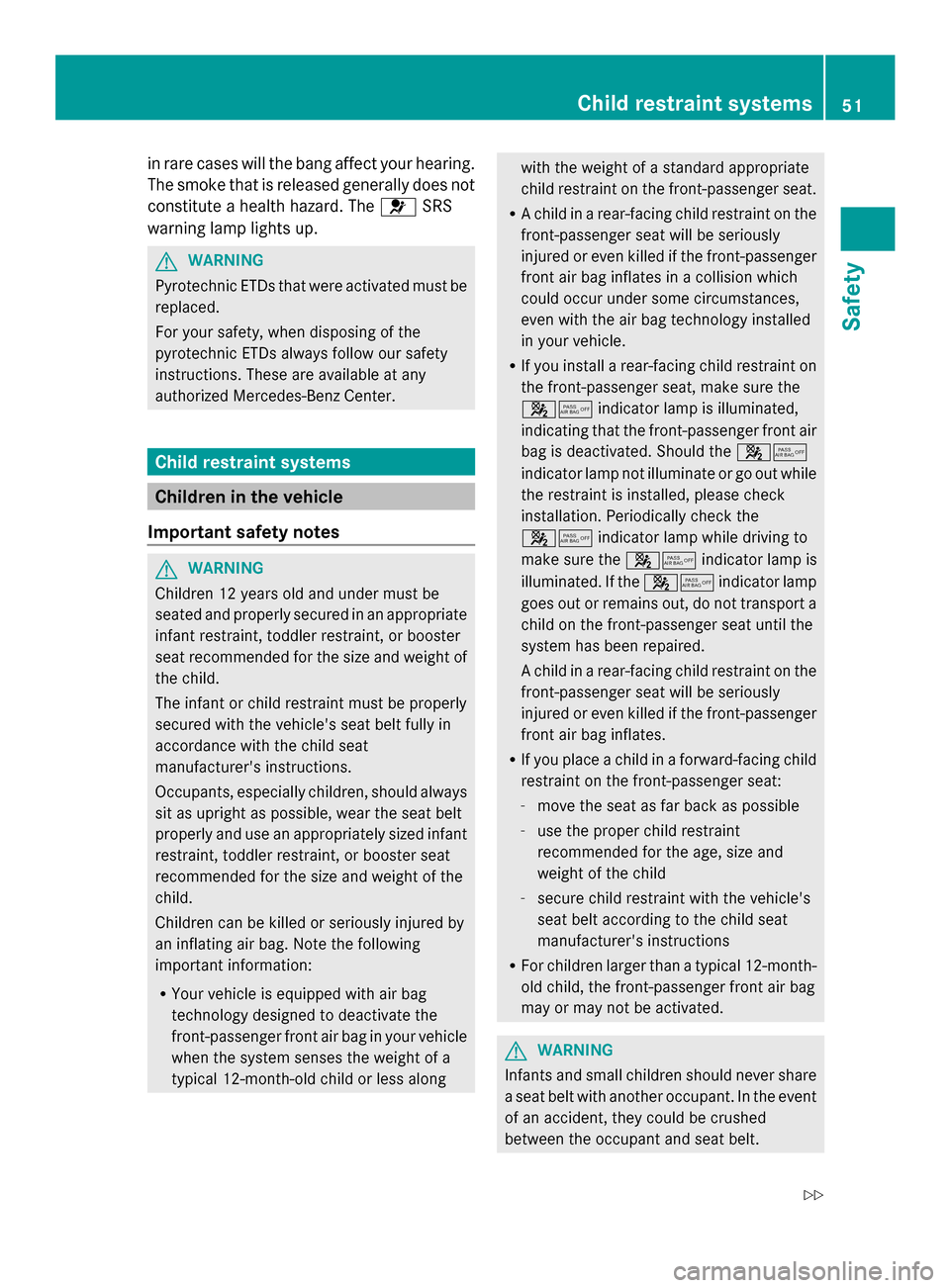
in rare cases will the bang affect your hearing.
The smoke that is released generally does not
constitute a health hazard. The 0075SRS
warning lamp lights up. G
WARNING
Pyrotechnic ETDs that were activated must be
replaced.
For your safety, when disposing of the
pyrotechnic ETDs always follow our safety
instructions. These are available at any
authorized Mercedes-Benz Center. Child restraint systems
Children in the vehicle
Important safety notes G
WARNING
Children 12 years old and under must be
seated and properly secured in an appropriate
infant restraint, toddler restraint, or booster
seat recommended for the size and weight of
the child.
The infant or child restraint must be properly
secured with the vehicle's seat belt fully in
accordance with the child seat
manufacturer's instructions.
Occupants, especially children, should always
sit as upright as possible, wear the seat belt
properly and use an appropriately sized infant
restraint, toddler restraint, or booster seat
recommended for the size and weight of the
child.
Children can be killed or seriously injured by
an inflating air bag. Note the following
important information:
R Your vehicle is equipped with air bag
technology designed to deactivate the
front-passenger front air bag in your vehicle
when the system senses the weight of a
typical 12-month-old child or less along with the weight of a standard appropriate
child restraint on the front-passenger seat.
R A child in a rear-facing child restraint on the
front-passenger seat will be seriously
injured or even killed if the front-passenger
front air bag inflates in a collision which
could occur under some circumstances,
even with the air bag technology installed
in your vehicle.
R If you install a rear-facing child restraint on
the front-passenger seat, make sure the
00730074 indicator lamp is illuminated,
indicating that the front-passenger front air
bag is deactivated. Should the 00730074
indicator lamp not illuminate or go out while
the restraint is installed, please check
installation. Periodically check the
00730074 indicator lamp while driving to
make sure the 00730074indicator lamp is
illuminated. If the 00730074indicator lamp
goes out or remains out, do not transport a
child on the front-passenger seat until the
system has been repaired.
A child in a rear-facing child restraint on the
front-passenger seat will be seriously
injured or even killed if the front-passenger
front air bag inflates.
R If you place a child in a forward-facing child
restraint on the front-passenger seat:
-move the seat as far back as possible
- use the proper child restraint
recommended for the age, size and
weight of the child
- secure child restraint with the vehicle's
seat belt according to the child seat
manufacturer's instructions
R For children larger than a typical 12-month-
old child, the front-passenger front air bag
may or may not be activated. G
WARNING
Infants and small children should never share
a seat belt with another occupant. In the event
of an accident, they could be crushed
between the occupant and seat belt. Child restraint systems
51Safety
Z
Page 57 of 290
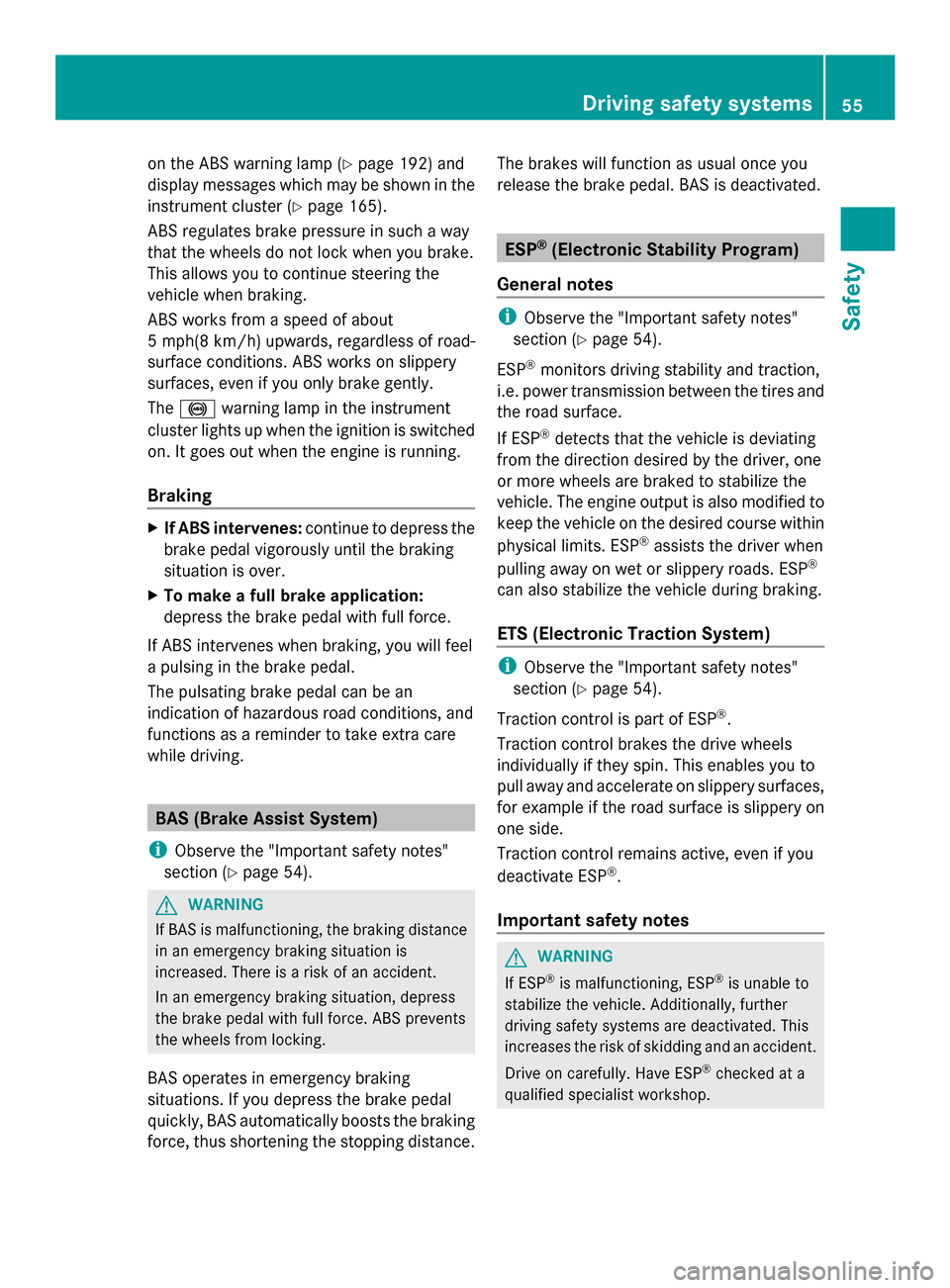
on the ABS warning lamp (Y
page 192) and
display messages which may be shown in the
instrument cluster (Y page 165).
ABS regulates brake pressure in such a way
that the wheels do not lock when you brake.
This allows you to continue steering the
vehicle when braking.
ABS works from a speed of about
5 mph(8 km/h) upwards, regardless of road-
surface conditions. ABS works on slippery
surfaces, even if you only brake gently.
The 0025 warning lamp in the instrument
cluster lights up when the ignition is switched
on. It goes out when the engine is running.
Braking X
If ABS intervenes: continue to depress the
brake pedal vigorously until the braking
situation is over.
X To make a full brake application:
depress the brake pedal with full force.
If ABS intervenes when braking, you will feel
a pulsing in the brake pedal.
The pulsating brake pedal can be an
indication of hazardous road conditions, and
functions as a reminder to take extra care
while driving. BAS (Brake Assist System)
i Observe the "Important safety notes"
section (Y page 54). G
WARNING
If BAS is malfunctioning, the braking distance
in an emergency braking situation is
increased. There is a risk of an accident.
In an emergency braking situation, depress
the brake pedal with full force. ABS prevents
the wheels from locking.
BAS operates in emergency braking
situations. If you depress the brake pedal
quickly, BAS automatically boosts the braking
force, thus shortening the stopping distance. The brakes will function as usual once you
release the brake pedal. BAS is deactivated. ESP
®
(Electronic Stability Program)
General notes i
Observe the "Important safety notes"
section (Y page 54).
ESP ®
monitors driving stability and traction,
i.e. power transmission between the tires and
the road surface.
If ESP ®
detects that the vehicle is deviating
from the direction desired by the driver, one
or more wheels are braked to stabilize the
vehicle. The engine output is also modified to
keep the vehicle on the desired course within
physical limits. ESP ®
assists the driver when
pulling away on wet or slippery roads. ESP ®
can also stabilize the vehicle during braking.
ETS (Electronic Traction System) i
Observe the "Important safety notes"
section (Y page 54).
Traction control is part of ESP ®
.
Traction control brakes the drive wheels
individually if they spin. This enables you to
pull away and accelerate on slippery surfaces,
for example if the road surface is slippery on
one side.
Traction control remains active, even if you
deactivate ESP ®
.
Important safety notes G
WARNING
If ESP ®
is malfunctioning, ESP ®
is unable to
stabilize the vehicle. Additionally, further
driving safety systems are deactivated. This
increases the risk of skidding and an accident.
Drive on carefully. Have ESP ®
checked at a
qualified specialist workshop. Driving safety systems
55Safety Z
Page 58 of 290
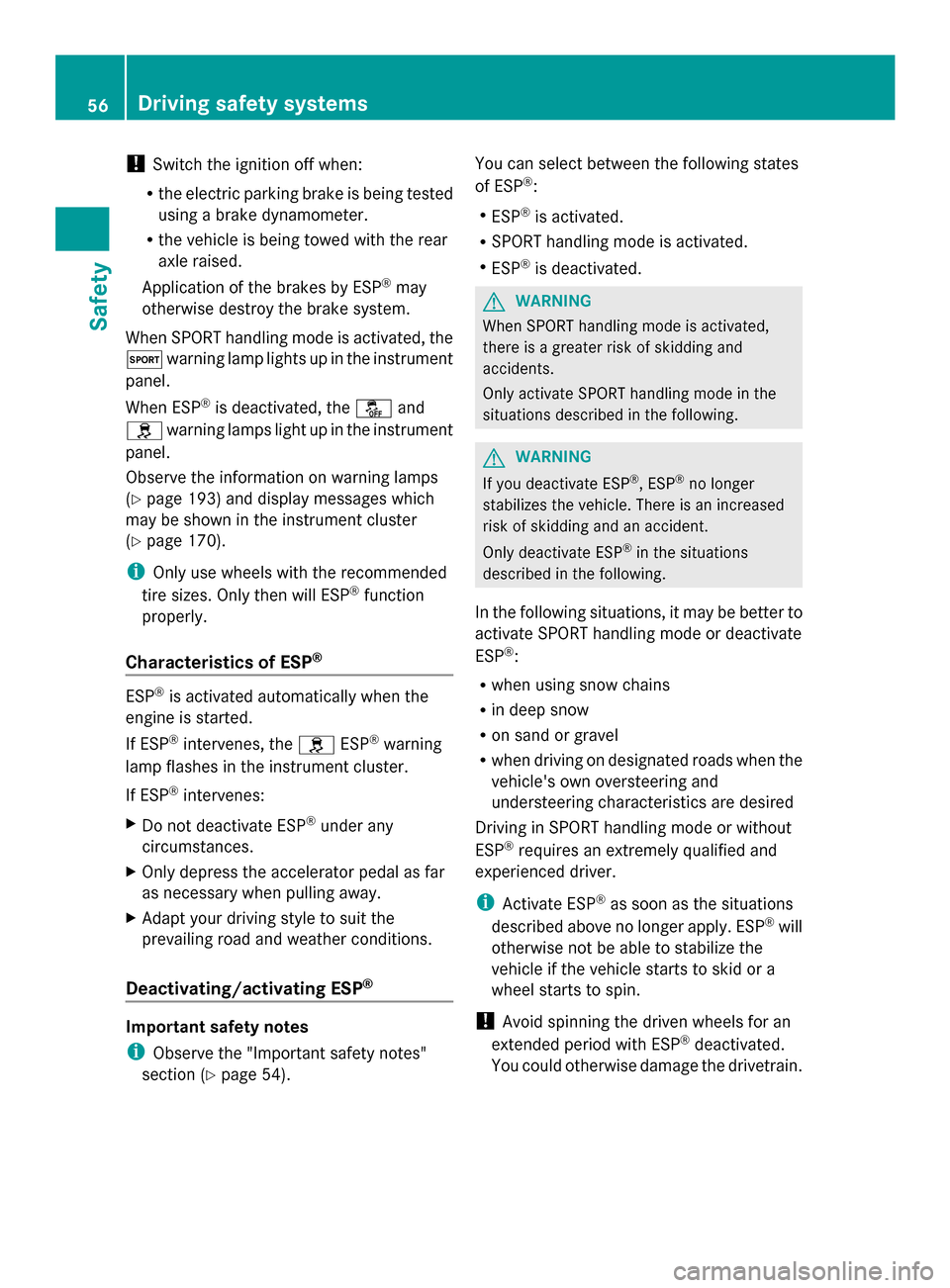
!
Switch the ignition off when:
R the electric parking brake is being tested
using a brake dynamometer.
R the vehicle is being towed with the rear
axle raised.
Application of the brakes by ESP ®
may
otherwise destroy the brake system.
When SPORT handling mode is activated, the
0074 warning lamp lights up in the instrument
panel.
When ESP ®
is deactivated, the 00BBand
0089 warning lamps light up in the instrument
panel.
Observe the information on warning lamps
(Y page 193) and display messages which
may be shown in the instrument cluster
(Y page 170).
i Only use wheels with the recommended
tire sizes. Only then will ESP ®
function
properly.
Characteristics of ESP ®ESP
®
is activated automatically when the
engine is started.
If ESP ®
intervenes, the 0089ESP®
warning
lamp flashes in the instrument cluster.
If ESP ®
intervenes:
X Do not deactivate ESP ®
under any
circumstances.
X Only depress the accelerator pedal as far
as necessary when pulling away.
X Adapt your driving style to suit the
prevailing road and weather conditions.
Deactivating/activating ESP ®Important safety notes
i
Observe the "Important safety notes"
section (Y page 54). You can select between the following states
of ESP
®
:
R ESP ®
is activated.
R SPORT handling mode is activated.
R ESP ®
is deactivated. G
WARNING
When SPORT handling mode is activated,
there is a greater risk of skidding and
accidents.
Only activate SPORT handling mode in the
situations described in the following. G
WARNING
If you deactivate ESP ®
, ESP ®
no longer
stabilizes the vehicle. There is an increased
risk of skidding and an accident.
Only deactivate ESP ®
in the situations
described in the following.
In the following situations, it may be better to
activate SPORT handling mode or deactivate
ESP ®
:
R when using snow chains
R in deep snow
R on sand or gravel
R when driving on designated roads when the
vehicle's own oversteering and
understeering characteristics are desired
Driving in SPORT handling mode or without
ESP ®
requires an extremely qualified and
experienced driver.
i Activate ESP ®
as soon as the situations
described above no longer apply. ESP ®
will
otherwise not be able to stabilize the
vehicle if the vehicle starts to skid or a
wheel starts to spin.
! Avoid spinning the driven wheels for an
extended period with ESP ®
deactivated.
You could otherwise damage the drivetrain. 56
Driving safety systemsSafety
Page 59 of 290

Deactivating/activating ESP
®X
To activate SPORT handling mode:
briefly press button 0043.
The 0074 handling mode warning lamp in
the instrument cluster lights up. The
SPORT handling mode
SPORT handling mode message appears
in the multifunction display.
X To deactivate SPORT handling mode:
briefly press button 0043.
The 0074 handling mode warning lamp in
the instrument cluster goes out. ESP ®
is
activated.
X To deactivate ESP ®
:press button 0043.
The 00BB ESP®
OFF warning lamp in the
instrument cluster lights up. The 00E5OFFOFF
message appears in the multifunction
display.
X To activate ESP ®
:when SPORT handling
mode is activated or ESP ®
is deactivated,
press button 0043.
The 00BB ESP®
OFF warning lamp in the
instrument cluster goes out. The 00E5ONON
message appears in the multifunction
display.
Characteristics of activated SPORT
handling mode
SPORT handling mode raises the intervention
threshold for stabilizing the vehicle. This
allows for a sportier driving style on
designated race circuits and may in certain
situations improve the traction in comparison
with ESP ®
. If SPORT handling mode is activated and one
or more wheels start to spin, the
0089
warning lamp in the instrument cluster
flashes. ESP ®
only stabilizes the vehicle to a
limited degree.
When SPORT handling mode is activated:
R ESP ®
only improves driving stability to a
limited degree.
R traction control is still activated.
R ESP ®
still provides support when you brake
firmly.
R engine torque is only restricted to a limited
degree, and the drive wheels are able to
spin. The spinning wheels produce a
cutting effect for better traction.
Characteristics when ESP ®
is deactivated
If ESP ®
is deactivated and one or more wheels
start to spin, the 0089warning lamp in the
instrument cluster does not flash. In such
situations, ESP ®
will not stabilize the vehicle.
If you deactivate ESP ®
:
R ESP ®
no longer improves driving stability.
R engine torque is no longer limited and the
drive wheels are able to spin. The spinning
of the wheels results in a cutting action for
better traction.
R traction control is still activated.
R ESP ®
still provides support when you brake
firmly. EBD (electronic brake force
distribution)
i Observe the "Important safety notes"
section (Y page 54). G
WARNING
If EBD has malfunctioned, the rear wheels can
still lock, e.g. under full braking. This
increases the risk of skidding and an accident.
You should therefore adapt your driving style
to the different handling characteristics. Have Driving safety syste
ms
57Safety
Z